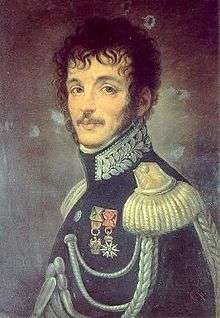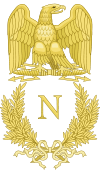Saint Helena Medal
| Saint Helena Medal | |
|---|---|
|
Obverse of the medal | |
|
Awarded by | |
| Type | Campaign medal |
| Eligibility | French and foreign soldiers |
| Awarded for | Military service during the 1792 to 1815 Napoleonic campaigns |
| Campaign | Napoleonic Wars |
| Statistics | |
| Established | 12 August 1857 |
| Total awarded |
~305,000 to Frenchmen ~55,000 to foreigners |
|
Ribbon bar of the medal | |



%2C_duc_de_Reggio.jpg)

The Saint Helena Medal (French: Médaille de Sainte-Hélène) was the first French campaign medal. It was established in 1857 by a decree of emperor Napoleon III to recognize participation in the campaigns led by emperor Napoleon I.[1]
Emperor Napoleon I, creator of the Legion of honour and various other orders, never instituted commemorative campaign medals for his brave soldiers. In time, many veterans of these campaigns, sometimes called the "débris de la Grande Armée" (English: "remnants of the Great Army"), began meeting within various new veterans' associations, keeping alive their war memories and the myth of Napoleon in popular culture, they issued many unofficial commemorative and associative medals.[2]
The need to adequately and officially recognize the service of these combat veterans was real, but it would be forty two years after the last battles and exile of the emperor to the island of Saint Helena before an imperial decree of emperor Napoleon III would create, on 12 August 1857,[3] the Saint Helena Medal.[2]
Award statute
The Saint Helena Medal was awarded to all French and foreign soldiers, from the land armies or naval fleets, who served the Republic or the Empire between the years 1792 and 1815.[3]
The medal was awarded with no condition of minimum time of service or participation in a particular military campaign, it was however necessary to prove ones right to the medal with a record of service or leave record.[2]
A later decree of 16 April 1864[4] added the Saint Helena Medal to the list of awards that could be revoked following a condemnation to a fixed prison term of one year or more for a crime committed by the recipient.
It was accompanied by an award certificate from the Grand Chancery of the Legion of honour and came in a white cardboard box with intricate ornamentation on the cover in the form of an embossed imperial eagle over the inscription on seven lines "AUX COMPAGNONS DE GLOIRE DE NAPOLÉON I DÉCRET IMPÉRIAL DU 12 AOÛT 1857" (English: "TO NAPOLEON I COMPANIONS IN GLORY IMPERIAL DECREE OF 12 AUGUST 1857").[2]
Award description
The Saint Helena Medal was of irregular shape and struck from bronze. It was a 2 cm in diameter circular medallion surrounded by a 50mm wide laurel wreath tied with a bow at the bottom. Atop the medal, a 2 cm wide Imperial Crown. The obverse of the medallion bore the relief image of the right profile of Emperor Napoleon I surrounded by the relief inscription "NAPOLEON I EMPEREUR" (English: "NAPOLEON I EMPEROR"). A ring or small orbs separated the central medallion from the wreath. Just below the image of the emperor, a small anchor, the privy mark of the award's designer, Désiré-Albert Barre.[3]
The reverse is identical except for the medallion which bore the relief circular inscription within a narrow 20mm band "CAMPAGNES DE 1792 A 1815" (English: "CAMPAIGNS OF 1792 TO 1815"). In the center, the relief inscription on nine lines "A" "SES" "COMPAGNONS" "DE GLOIRE" "SA DERNIÈRE" "PENSÉE" "STE HÉLÈNE" "5 MAI" "1821" (English: "TO HIS COMPANIONS IN GLORY HIS LAST THOUGHT ST HELENA 5 MAY 1821").[3]
The medal hung from a 38mm wide green silk moiré ribbon bearing five 1,8mm wide red vertical stripes spaced 4,5mm apart and 1mm red edge stripes.[3] The ribbon passed through a suspension ring itself passing through a lateral hole in the imperial crown's orb atop the medal.[2]
 Reverse of the St Helena medal.
Reverse of the St Helena medal. Award certificate.
Award certificate. Presentation box cover
Presentation box cover Emblem of the Imperial Great Army
Emblem of the Imperial Great Army Emperor Napoléon I
Emperor Napoléon I
Notable recipients (partial list)
- Marshal of France Jean-Baptiste Philibert Vaillant
- Marshal of France Bernard Pierre Magnan
- Marshal of France Aimable Pélissier
- Admiral Ferdinand-Alphonse Hamelin
- General Mathieu Brialmont
- Engineer general Jacques, comte Mallet
- General Émile Herbillon
- General Aristide de La Ruë
- General Charles Oudinot
- General Teodoro Lechi
- General François Martineau des Chesnez
- General Anne Charles Lebrun
- General Émile Mellinet
- General Casimir-Louis-Victurnien de Rochechouart de Mortemart
- General Albert Joseph Goblet d'Alviella
- General Vivant-Jean Brunet-Denon
- General Tomasz Łubieński
- General Pierre Schaken
- General Émile Perrodon
- General Pierre Chrétien Korte
- General Jean-Ernest Ducos de La Hitte
- Vice admiral Odet-Pellion
- Rear admiral Louis Tromelin
- Colonel Louis Auguste de Bourbel de Montpinçon
- Lieutenant colonel Louis-Casimir Teyssier
- Commander Joseph Toussaint Bernard
- Major Étienne Desjoyeaux
- Captain Jean-Joseph Charlier
- Captain Amédée de Bast
- Captain Claude Noisot
- Doctor François-Joseph Cazin
- Marcellin Jobard
- Nicolas Savin
See also
- French Imperial Eagle
- Grande Armée Slang
- List of French general officers (Peninsular War)
- Types of military forces in the Napoleonic Wars
- Uniforms of La Grande Armée
References
- ↑ Musée de la Légion d'Honneur permanent exhibit, Paris
- 1 2 3 4 5 "France Phaléristique web site" (in French). Marc Champenois. 2004-01-01. Retrieved 2013-10-28.
- 1 2 3 4 5 "Imperial Decree of 12 August 1857" (in French). Bibliothèque Nationale de France. 1857-08-12. Retrieved 2013-10-29.
- ↑ "Imperial Decree of 16 April 1864" (in French). Bibliothèque Nationale de France. 1864-04-16. Retrieved 2013-10-29.
